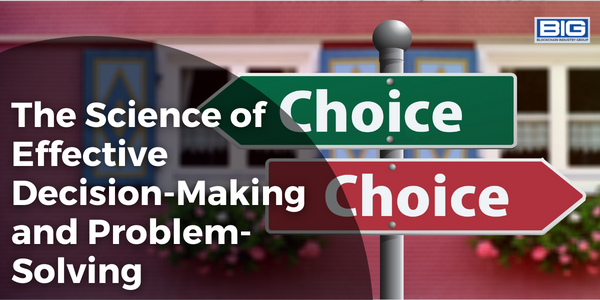
We’ve all been there, staring at a problem, wracking our brains for a solution, and feeling completely stuck. But what if I told you that there was a science to decision-making and problem-solving, and that by following some simple principles, you too could become a master of finding creative solutions?
That’s right, my friends. The art of problem-solving is not just for geniuses and experts, it’s for all of us. By understanding the science behind effective decision-making and problem-solving, we can equip ourselves with the tools we need to tackle any challenge that comes our way.
So, what are these principles? Let’s dive in!
Understanding the Problem
The first step in effective decision-making and problem-solving is understanding the problem. Seems simple enough, right? But in practice, this can be much harder than it sounds.
We often jump to conclusions, trying to find a solution before we fully understand the issue at hand. But this can lead to ineffective solutions, or even create new problems. To avoid this, it’s important to take the time to ask questions and gather information about the problem.
For example, let’s say you’re trying to figure out how to reduce waste in your office. Before you start brainstorming solutions, you’ll want to understand the root cause of the waste. Is it because employees aren’t recycling? Is it because there’s too much packaging on the products you buy? By asking these questions, you’ll get a better understanding of the problem and be able to come up with a more effective solution.
Brainstorming and Creativity
Once you have a good understanding of the problem, it’s time to start generating ideas. This is where brainstorming comes in. The goal of brainstorming is to generate as many ideas as possible, no matter how wacky or seemingly impossible they may seem.
But here’s the thing: we often limit ourselves, thinking that there’s only one solution to a problem. But by embracing our inner child and letting our imaginations run wild, we open up a world of possibilities. So go ahead, dream big. The goal is to generate as many ideas as possible, and worry about feasibility later.
For example, let’s say you’re trying to figure out how to make your daily commute more eco-friendly. During a brainstorming session, you might come up with ideas like carpooling, taking public transportation, biking, or even telecommuting. By having a diverse range of ideas, you’ll have a better chance of finding a solution that works for you.
Evaluation and Implementation
Now that you have a list of ideas, it’s time to evaluate them. This is where you’ll consider feasibility, cost, and impact. You’ll want to choose the solution that is most likely to succeed and have the greatest impact.
Once you’ve chosen a solution, it’s time to implement it. This may require planning, resources, and collaboration with others. But with a solid plan in place, and a commitment to making it work, you’ll be on your way to solving the problem once and for all.
For example, let’s say you’ve decided that carpooling is the best solution for your eco-friendly commute. You’ll want to find a carpool partner, figure out a schedule that works for both of you, and make a plan for what you’ll do in case of inclement weather. With these details ironed out, you’ll be well on your way to a greener commute.
Maintenance and Continuous Improvement
Making a decision and implementing a solution is just the first step. It’s also important to continuously monitor and evaluate the effectiveness of your solution. This allows you to identify any potential problems and make adjustments as needed.
For instance, if you find that your carpool schedule is causing stress, you may need to adjust the days or times that you carpool. Or if you find that one person is consistently late, you may need to come up with a solution to ensure that everyone is on time.
The Secrets of Good Communication Skills
—
Tips for Parenting Strong and Independent Children
—
Unlocking the Power of Creative Thinking
Continuous improvement is a key aspect of effective decision-making and problem-solving. It ensures that you stay on track and continue to make progress towards your goal.
Conclusion
In conclusion, effective decision-making and problem-solving are critical skills that can greatly improve your life. By using a structured process, evaluating potential solutions, and continuously monitoring progress, you’ll be well on your way to success. So the next time you’re faced with a problem, remember to take a step back, analyze the situation, and make a plan for how you’ll solve it. You got this!



